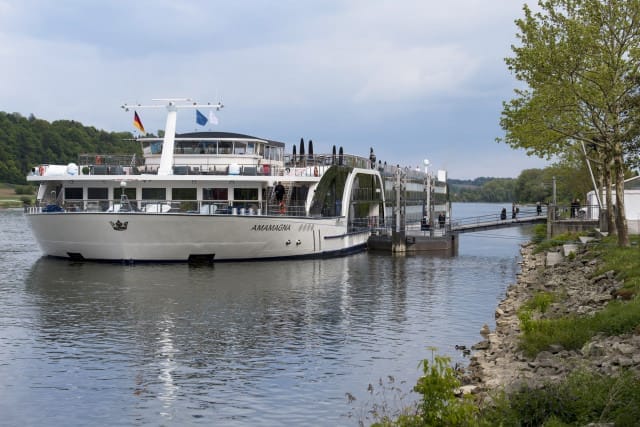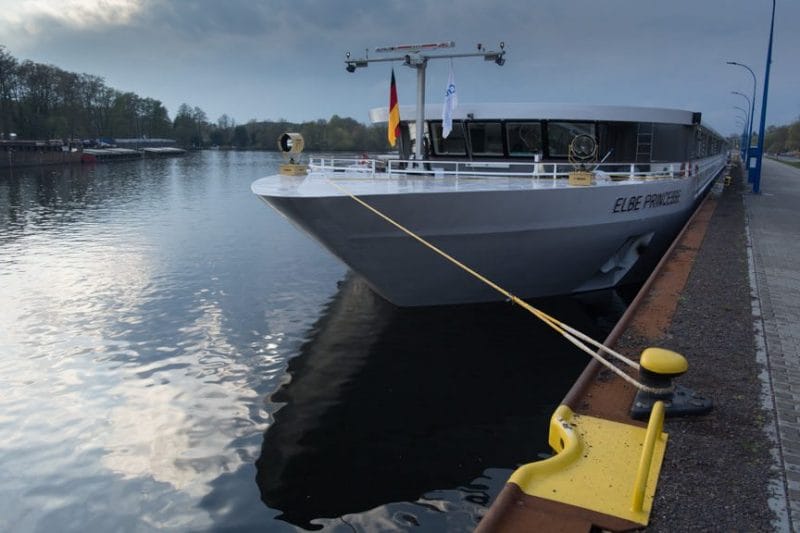
While there are invariably differences between vessels—some boast indoor pools, spas, multiple restaurants and whatnot—these are the basic categories to help you wade through what’s out there.
What Are River Cruisers?
These are the biggies, carrying between 98 and 200 guests. These elongated, flat and sleek vessels make up the majority within the leisure river cruising industry, appearing somewhat like squashed ocean liners. The low profiles, no more than four decks high, allow for the ships to maneuver under bridges and maintain a shallower draft. Some are shorter in length—such as the 103-foot Juno, cruising Sweden’s canals—but most hover somewhere around 400 feet in length and 40 feet in width.
Two exceptions to this last dimension are AmaMagna and Riverside Mozart. These ships are nearly twice the width of most river cruisers, making even more room for public spaces like the multiple dining venues and staterooms with king-sized beds.
You may be wondering, if that’s a river cruiser, than what exactly is a “longship”? This is simply the term that Viking River Cruises coined (well, and the original Vikings, of course) to be inline with its moniker, but it’s simply a river cruiser. The same goes for Emerald Cruises “Star Ships,” Scenic’s “Space Ships,” and Avalon’s “Suite Ships.”

River cruisers don’t always match the luxury standards of their ocean-going counterparts, but they do come close. As for what’s included and what’s not on a river cruise, refer to our chart for a company-by-company comparison.
Attributes Of The Top River Cruise Companies
| AmaWaterways | Avalon | CroisiEurope | Emerald | Riverside | Riviera | Scenic | Tauck | Uniworld | Viking | ||
|---|---|---|---|---|---|---|---|---|---|---|---|
| Excursions Included? | |||||||||||
| Beer/Wine Lunch & Dinner? | ** | ||||||||||
| Onboard Bicycles | |||||||||||
| Fitness Center | |||||||||||
| Exterior Balconies/Veranda | |||||||||||
| Two Room Suites | |||||||||||
| Own & Operate | |||||||||||
| Room Service | ** | ** | |||||||||
| Mini Bar | ** | ** | |||||||||
| Dining Venues | 3** | 2** | 1 | 3 | 5 | 2 | 6 | 2 | ** | 2 | |
| Personal Butler | |||||||||||
| Port Charges Included | |||||||||||
| Airport Transfers | ** | ** | ** | ||||||||
| Prepaid Gratuities | ** | ||||||||||
| Gratuities Included | ** | ||||||||||
| Laundry Included | ** | ** | ** |
What Are Barges?

The differences between river cruisers and barges are vast but essentially boils down to this: Barges are much smaller, are able to navigate canals as well as rivers, and host no more than two dozen people. Typically, you’ll travel with friends and family, or like-minded individuals, on quiet waterways through bucolic countryside. Your means of conveyance, referred to as “luxury hotel barges”, feature all-inclusive menus that include tours, bikes, beverages and gourmand-worthy cuisine.
Because of the size of the vessels, canal cruises represent more intimate experiences than those found on river cruises, and you’ll often pay handsomely for this autonomy. Luxury barge cruises along the picturesque canals of France are not inexpensive vacation experiences. Rates ranges from $300 per person per day up to more than $1,000 per person per day, plus suggested gratuities from 5 percent to 10 percent of the total cost of the cruise depending on how generous you’re feeling.
On a per-diem basis, barge cruises are certainly among the most expensive travel experiences offered, but as is often said, you get what you pay for. At these prices, you better. What we learned in talking with guests is that for some of them, six days on a barge through a small slice of France was a lifetime aspiration that they had spent years saving for.
There are aspects of barging that seem disparate with the price tag: Staterooms, for example, are typically small but well-configured on the hotel barges. And, while it’s not true across the board, they tend have much more casual and understated decor.
Often these vessels once carried cargo and were gutted to house a “hotel” structure. It’s best to refer to them as “luxury hotel barges” to counter the common association of cargo barges. Unless you’ve been swindled, you won’t be traveling with coal or cattle. A few examples of companies offering barge sailings in Europe include CroisiEurope, European Waterways and French Country Waterways.
Due to their size and accompanying engine power, barges move at slower pace than river cruisers, allowing for you to step off at locks to walk, run or ride bikes. Our typical day aboard barges go something like this: Wake up, have breakfast. Go out on the sun deck and watch the landscape pass by. Step off at a lock to bicycle for a couple of hours. Return to the barge for lunch. Join an afternoon guided tour, and return to the barge for fine dining and comfortable accommodations.
We created a short video that takes you aboard a barge cruise, and while it was filmed in 2012, it will give you a sense of what a barge vacation is all about.
What Are Paddlewheelers?

This type of vessel is pretty much self explanatory; attached to the stern it bears telltale paddlewheels driving the ship. Paddlewheel propulsion, shallow hull draft, low air draft and a ballasting system allows the vessel to navigate notoriously shallow rivers such as the Elbe and Loire. Powered only by paddlewheels, its cruising speed will reach up to nearly 10 mph. This technology also makes it feasible to sail year-round out of places like Berlin, even during low-water season. Since this is such an exclusive collection, I’m adding a few more details about each paddlewheel vessel’s features.
Paddlewheelers in Europe pale in comparison to the size of some of those churning along the Mississippi and are certainly less plentiful.
One example is CroisiEurope’s, Loire Princesse. Loire Princesse, as the name suggests, was designed specifically to sail its namesake river. Dotted with spectacular scenery, beautiful chateaux and UNESCO World Heritage Sites, the Loire is a veritable wealth of cities and regions that, until April of 2015 when this vessel set sail, had never been accessible by a river cruisers with staterooms designed for overnight stays. Dubbed a “Green Ship” thanks to environmentally-friendly technologies, Loire Princesse is 295 feet long with a beam of 49 feet, capable of accommodating up to 96 guests in a total of 48 staterooms, many with balconies. Onboard amenities include a full-service restaurant, inviting Lounge with a dedicated dance floor and a sun deck that is perfectly suited to outdoor viewing.
Read more details about life aboard a paddlewheeler in my voyage recaps:
